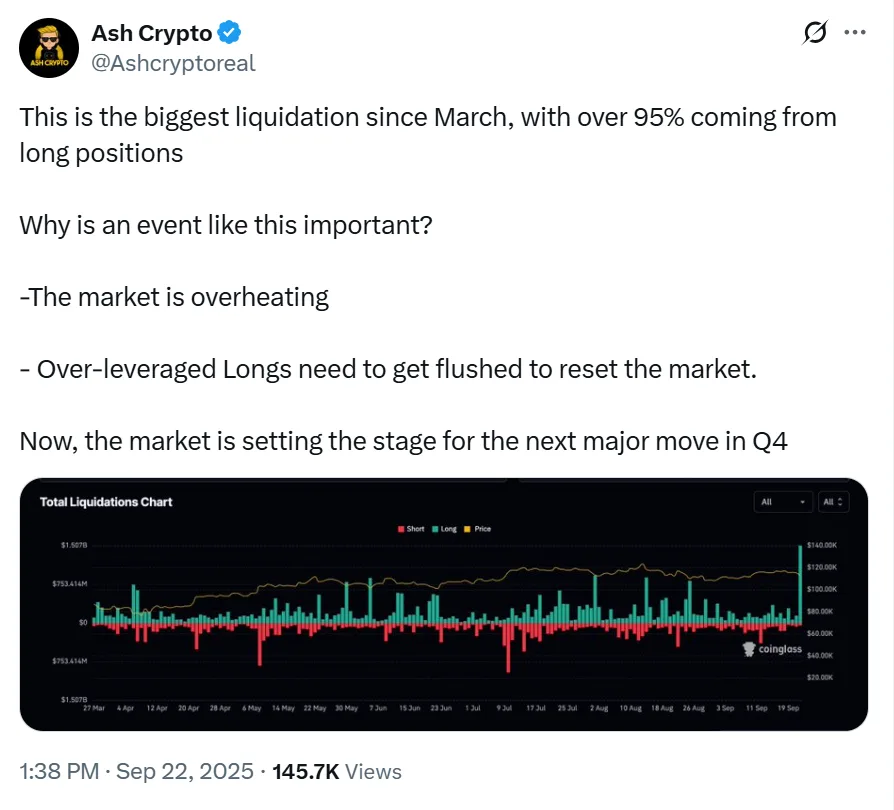Volatility speaks volumes at the moment. The crypto market is weary with several major coins crying to regain their previous highs. A total of $220 billion worth of coins was liquidated from the market a few hours ago. Bitcoin hangs at $112,800 and Ethereum dipped to $4,182, marking a 6.28% dip in the past 24 hours, at press time.
Fed Rate cut sparks modest market rebound
Although the 0.25% interest rate cut impacted the crypto market, taking Bitcoin’s price to $118,000, the market responded to the bullish stint only for a while. Just a day after the spike followed dip, and Bitcoin went down to $115,000, currently hovering at $112,800.
Large liquidation puts crypto in pain
Before we dive in, let’s know what liquidation means in this scenario. Liquidation occurs when an exchange forcibly closes a trader’s leveraged positions as their collateral can no longer cover losses.
For example, a trader has $1,000 and uses 10x leverage. He can open a position worth $10,000. He can earn a profit if the market moves in his favor; however, he loses if it moves against them, making the trader’s collateral insufficient to cover the losses. At this point, exchanges automatically liquidate or force-sell the assets to stop further loss.
Over $1.68 billion in positions were liquidated in the past 24 hours, according to CoinMarketCap. Meanwhile, the market saw a $220 billion wipeout some hours ago.
Liquidation happens at the trader level, whereas wiping out happens at the market level, meaning the total market cap drops.
When huge billions in crypto liquidate, the market sweats and responds bearish. This phenomenon is quite clear from the current status of the market. From last week’s $4 trillion, the crypto market cap shrank to $3.89 trillion, which is nearly 3.6% down in the past 24 hours.
BREAKING:
— Ash Crypto (@Ashcryptoreal) September 22, 2025
A TOTAL OF $220 BILLION HAS BEEN WIPED OUT FROM THE CRYPTO MARKET IN THE LAST 24 HOURS pic.twitter.com/z00j84lZJc
How does huge liquidation impact crypto market?
Forced selling
As traders who leveraged/borrowed money get liquidated, exchanges automatically sell off their positions in order to cover losses, creating a sudden selling pressure. A sudden selling pressure mostly leads to a price dip.
Liquidation cascade
A chain reaction happens during huge liquidations.
Prices drop → forced liquidation → selling pressure → price goes down further → more positions liquidate. This cycle repeats, causing a liquidation cascade.
Volatility surge
Notable liquidation events lead to wild price swings. The recent $1.68 billion liquidation caused sharp drops in Bitcoin, Ethereum, XRP, Solana, Cardano, and all other major cryptocurrencies.
Market sentiment changes
Huge liquidation can also spread fear and uncertainty, making even spot traders sell their coins. Some traders avoid new positions and withdraw their funds, deepening the sink.
Liquidity drain
When multiple positions are liquidated at the same time, exchanges may sell assets at the worst prices. With more forced sellers and fewer buyers, the cryptocurrency market becomes fragile.
Experts say liquidations surge from leverage
Speaking to a media outlet, Dan Dadybayo, research and strategy lead at Unstoppable Wallet, highlighted: “The $1.7 billion in liquidations reflects an aggressive flush of leverage from the system”.
Another crypto trader wrote on X that multiple traders were using excessive leverage, causing an unstable market. For him, wiping out over-leveraged long positions indicates the market needs a reset. “Clearing over-leveraged longs cools down overheated conditions and often sets the stage for a more sustainable rally. Q4 could see some strong moves if the market stabilizes.”
Additionally, the current liquidation is the biggest since March, with more than 95% coming from long positions.

Liquidation is not just a trader’s nightmare. It is also a significantly painful journey for the market. When billions worth of crypto vanish within hours, the entire cryptosphere suffers, from Bitcoin’s decoupling to sharp price swings in other altcoins. Although the market is unhappy due to the ongoing crisis, it has strong potential to regain strength, especially if a second interest rate cut happens in October.














